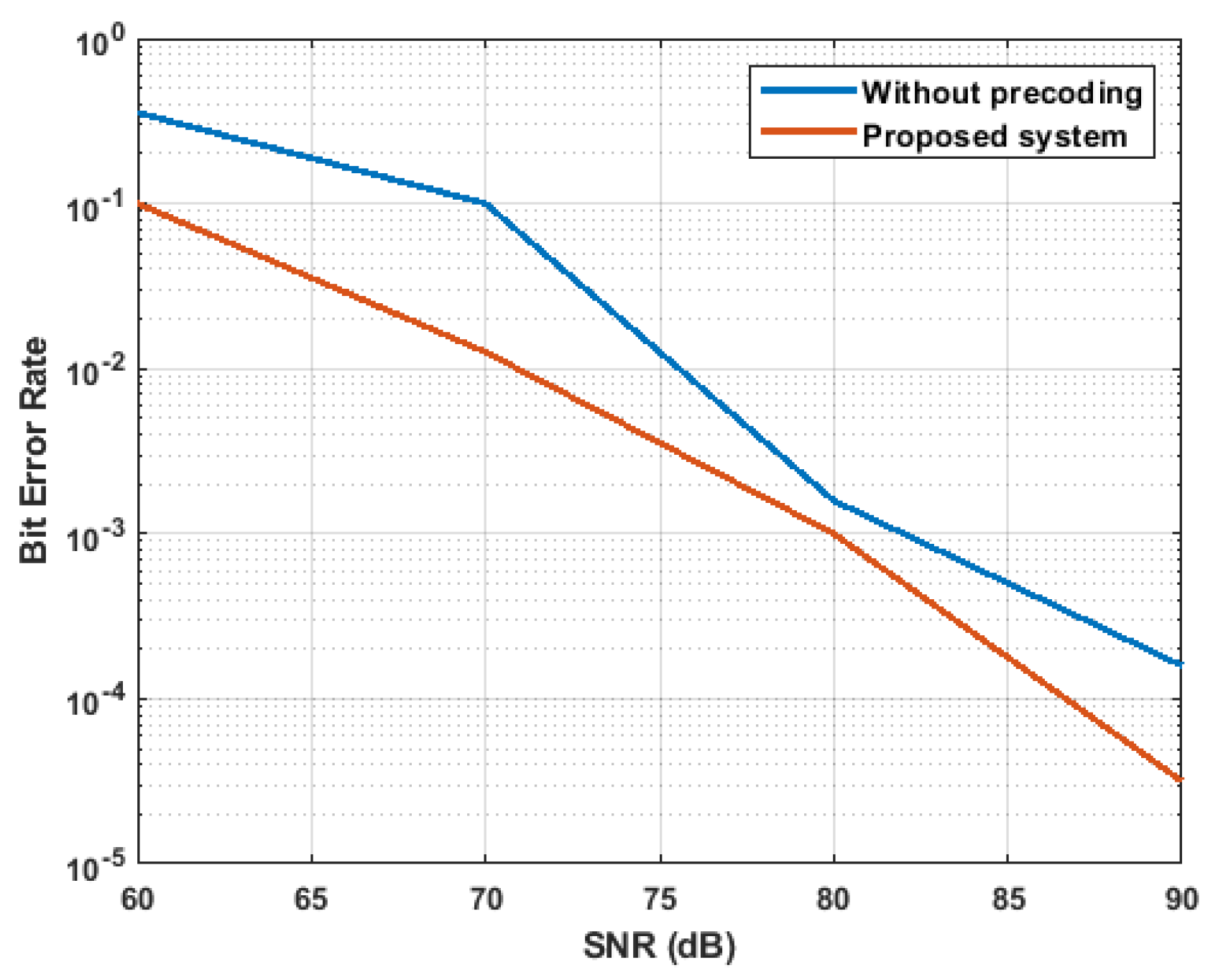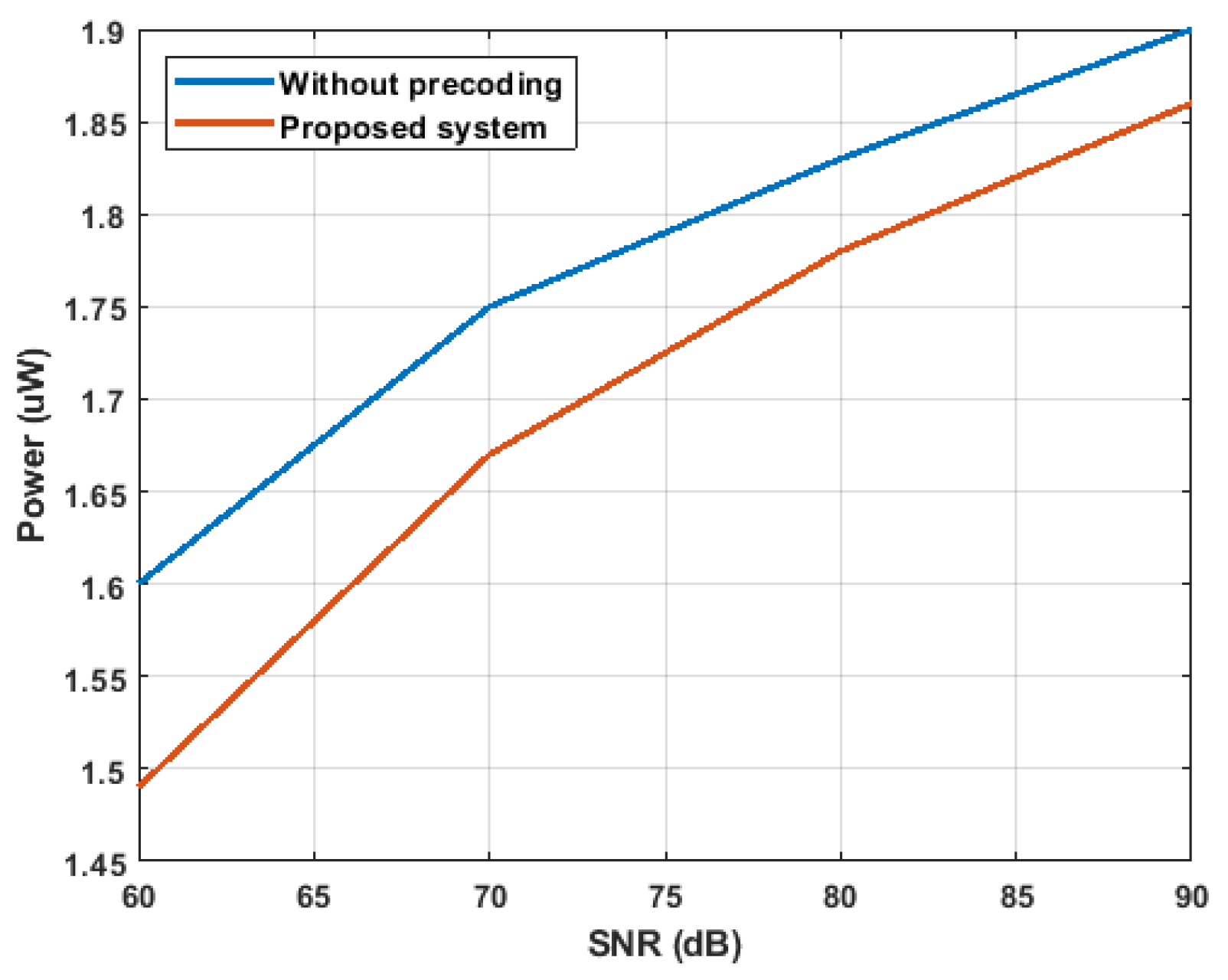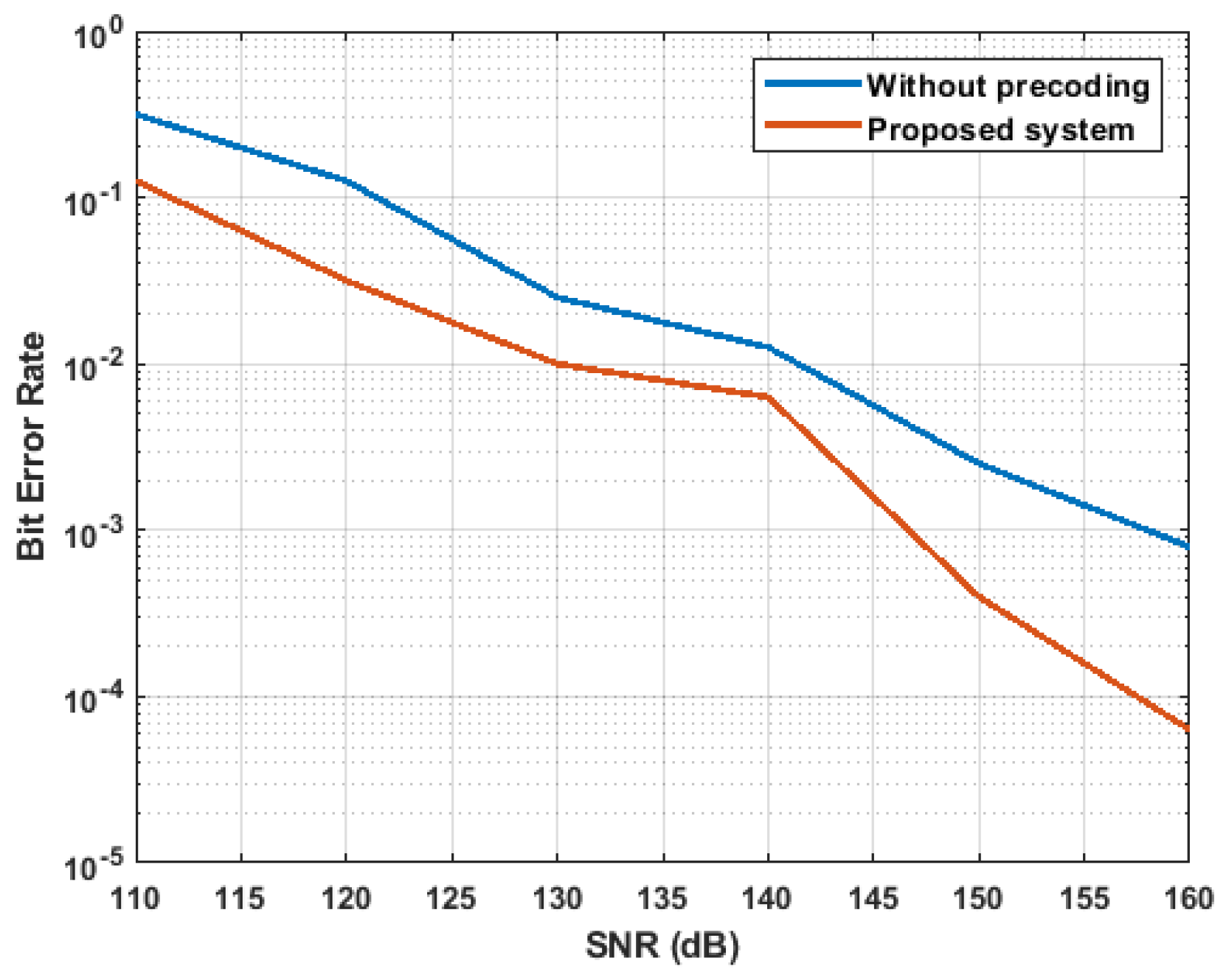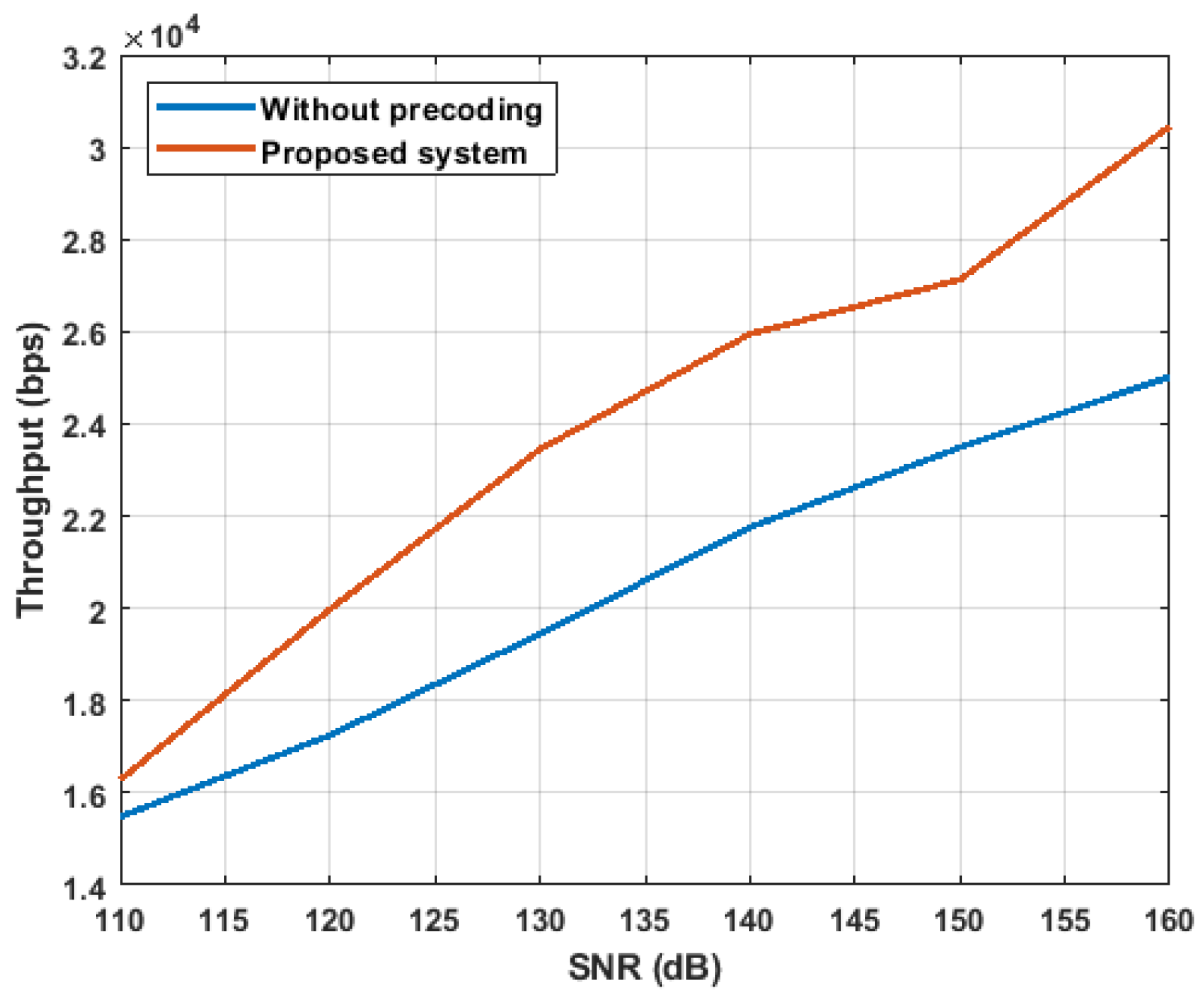A Block Bi-Diagonalization-Based Pre-Coding for Indoor Multiple-Input-Multiple-Output-Visible Light Communication System
Abstract
:1. Introduction
- In this paper, a indoor MIMO-VLC system is developed to improve the data rate and reliability in data transmission. Here, is defined as the installation of LEDs in the transmitter side and PDs in the receiver side.
- Block Bi-Diagonalization (BBD)-based precoding is presented in this communication system to remove the inferences caused due to the thermal noise, shot noise and phase noise. This is because these noise constraints affect the signal, which is transmitted through the MIMO-VLC system. Additionally, the BBD-based precoding used in this VLC system has less computation complexity.
- Quadrature Amplitude Modulation (QAM)-based modulation also improves the transmission of the MIMO-VLC transmitter. The Bit Error Rate (BER) and throughput of the proposed system are analyzed for three different scenarios under noise constraints.
2. Literature Survey
3. Proposed System
3.1. System Model
3.2. Channel Model of the Indoor MIMO-VLC System
3.3. Optimal Precoding Using Block Bi-Diagonalization
4. Results and Discussion
4.1. Performance Measure
- Bit Error RateThe amount of errors at a specified unit time is called the BER. Generally, the BER is the ratio rate between the amount of error bits to the total transmitted bits over the MIMO-VLC channel and the Equation (17) expresses the BER.
- ThroughputThroughput is defined as number of bits transmitted from one place to another place. Generally, throughput is measured as bits per second.
4.2. Performance Analysis
4.3. Comparative Analysis
5. Conclusions
Author Contributions
Funding
Conflicts of Interest
References
- Wang, Q.; Wang, Z.; Dai, L. Multiuser MIMO-OFDM for visible light communications. IEEE Photonics J. 2015, 7, 1–11. [Google Scholar] [CrossRef]
- Jain, S.; Mitra, R.; Bhatia, V. Adaptive precoding-based detection algorithm for massive MIMO visible light communication. IEEE Commun. Lett. 2018, 22, 1842–1845. [Google Scholar] [CrossRef]
- Sifaou, H.; Kammoun, A.; Park, K.H.; Alouini, M.S. Robust transceivers design for multi-stream multi-user MIMO visible light communication. IEEE Access 2017, 5, 26387–26399. [Google Scholar] [CrossRef] [Green Version]
- Feng, R.; Dai, M.; Wang, H.; Chen, B.; Lin, X. Linear precoding for multiuser visible-light communication with field-of-view diversity. IEEE Photonics J. 2016, 8, 1–8. [Google Scholar] [CrossRef]
- Kumar, C.R.; Jeyachitra, R.K. Power efficient generalized spatial modulation MIMO for indoor visible light communications. IEEE Photonics Technol. Lett. 2017, 29, 921–924. [Google Scholar] [CrossRef]
- Abdulkafi, A.A.; Hardan, S.M.; Bayat, O.; Ucan, O.N. Multilayered optical OFDM for high spectral efficiency in visible light communication system. Photonic Netw. Commun. 2019, 38, 299–313. [Google Scholar] [CrossRef]
- Dai, M.; Yuan, J.; Feng, R.; Wang, H.; Chen, B.; Lin, X. A power allocation method for 2 × 2 VLC-MIMO indoor communication. Opt. Rev. 2016, 23, 678–682. [Google Scholar] [CrossRef]
- Chen, C.; Zhong, W.D.; Wu, D. On the coverage of multiple-input multiple-output visible light communications. IEEE/OSA J. Opt. Commun. Netw. 2017, 9, D31–D41. [Google Scholar] [CrossRef]
- Esmail, M.A.; Fathallah, H.A. Indoor visible light communication without line of sight: Investigation and performance analysis. Photonic Netw. Commun. 2015, 30, 159–166. [Google Scholar] [CrossRef]
- Werfli, K.; Chvojka, P.; Ghassemlooy, Z.; Hassan, N.B.; Zvanovec, S.; Burton, A.; Haigh, P.A.; Bhatnagar, M.R. Experimental demonstration of high-speed 4 × 4 imaging multi-CAP MIMO visible light communications. J. Light. Technol. 2018, 36, 1944–1951. [Google Scholar] [CrossRef] [Green Version]
- Chen, C.; Zhong, W.D.; Yang, H.; Du, P. On the performance of MIMO-NOMA-based visible light communication systems. IEEE Photonics Technol. Lett. 2017, 30, 307–310. [Google Scholar] [CrossRef]
- Yang, H.; Chen, C.; Zhong, W.D.; Alphones, A. Joint precoder and equalizer design for multi-user multi-cell MIMO VLC systems. IEEE Trans. Veh. Technol. 2018, 67, 11354–11364. [Google Scholar] [CrossRef]
- Ali, T.; Balani, W. A robust pre-coding and hybrid equalization assisted MIMO-MU visible light communication system for QoS centric indoor communication. Telecommun. Syst. 2019, 72, 457–470. [Google Scholar] [CrossRef]
- Zhu, Y.J.; Liang, W.F.; Zhang, J.K.; Zhang, Y.Y. Space-collaborative constellation designs for MIMO indoor visible light communications. IEEE Photonics Technol. Lett. 2015, 27, 1667–1670. [Google Scholar]
- Sun, Z.G.; Yu, H.Y.; Tian, Z.J.; Zhu, Y.J. Linear precoding for MU-MISO VLC systems with noisy channel state information. IEEE Commun. Lett. 2018, 22, 732–735. [Google Scholar] [CrossRef]
- Hsu, C.W.; Chow, C.W.; Lu, I.C.; Liu, Y.L.; Yeh, C.H.; Liu, Y. High speed imaging 3 × 3 MIMO phosphor white-light LED based visible light communication system. IEEE Photonics J. 2016, 8, 1–6. [Google Scholar] [CrossRef]
- Wang, R.; Gao, Q.; You, J.; Liu, E.; Wang, P.; Xu, Z.; Hua, Y. Linear transceiver designs for MIMO indoor visible light communications under lighting constraints. IEEE Trans. Commun. 2017, 65, 2494–2508. [Google Scholar] [CrossRef]
- Park, K.H.; Oubei, H.M.; Alheadary, W.G.; Ooi, B.S.; Alouini, M.S. A Novel Mirror-Aided Non-Imaging Receiver for Indoor 2 × 2 MIMO-Visible Light Communication Systems. IEEE Trans. Wirel. Commun. 2017, 16, 5630–5643. [Google Scholar] [CrossRef] [Green Version]
- Kim, B.W.; Jung, S.Y. Channel capacity of the distributed MIMO relay in visible light communication systems. Photonic Netw. Commun. 2017, 34, 298–305. [Google Scholar] [CrossRef]
- Akande, K.O.; Popoola, W.O. MIMO techniques for carrierless amplitude and phase modulation in visible light communication. IEEE Commun. Lett. 2018, 22, 974–977. [Google Scholar] [CrossRef]
- Hong, Y.; Wu, T.; Chen, L.K. On the performance of adaptive MIMO-OFDM indoor visible light communications. IEEE Photonics Technol. Lett. 2016, 28, 907–910. [Google Scholar] [CrossRef]
- Marshoud, H.; Sofotasios, P.C.; Muhaidat, S.; Sharif, B.S.; Karagiannidis, G.K. Optical adaptive precoding for visible light communications. IEEE Access 2018, 6, 22121–22130. [Google Scholar] [CrossRef]
- Sathar, A.A.; Muneer, P.; Ijyas, V.T.; Usman, M.; Shamim, M.Z.M.; Shiblee, M. Filter-Bank Modulation Based Signal Design and Transmission Techniques for Intensity Modulated MIMO Visible Light Communication Systems. Wirel. Pers. Commun. 2019, 111, 1129–1150. [Google Scholar] [CrossRef]
- Kumar, A.; Ghorai, S.K. Effect of multipath reflection on BER performance of indoor MIMO-VLC system. Opt. Quantum Electron. 2018, 50, 388. [Google Scholar] [CrossRef]











| Parameter | Description |
|---|---|
| Number of transmitting LEDs | |
| Number of receiving LEDs | |
| Input signal vector | |
| Received signal vector | |
| DC bias matrix | |
| Noise vector | |
| Square matrix | |
| Desired channel paths | |
| Interference channel paths | |
| Responsivity | |
| Transmitting power of LED | |
| Receiver noise | |
| Thermal noise | |
| Shot noise | |
| Electronic charge | |
| Bandwidth | |
| Background current | |
| bandwidth factor of noise | |
| Boltzmann’s constant | |
| Absolute temperature | |
| Gain of open-loop voltage | |
| Area of PD | |
| PD’s fixed capacitance | |
| Channel noise factor of field effect transistor | |
| Transconductance of the FET | |
| Weighting function | |
| Signal to interference plus noise ratio (SINR) in th PD | |
| Distance among the transmitting LED and PD receiver | |
| Emergence angle | |
| Incidence angle | |
| PD’s field of view | |
| Optical filter’s gain | |
| Optical concentrator’s gain | |
| Transmitting LED’s Lambertian radiant intensity | |
| Transmitter semiangle at half power | |
| SVD of BBD’s Square matrix | |
| Left singular vector matrix | |
| Right singular vector matrix | |
| Zero matrix | |
| Precoding matrix |
| Parameters of LED Transmitter | |
| Amount of LEDs per luminary | 6060 |
| LED transmitter power | 10 mW |
| Semi angle of transmitter | 15° |
| Parameters of PD Receiver | |
| FOV of receiver | 15° |
| PD area | 1.0 cm2 |
| PD responsivity | 1 A/W |
| PD lens’ refractive index | 1.5 |
| Gain of optical filter | 1.0 |
| Background current | 100 |
| Bandwidth factor of noise | 0.562 |
| Scenario 1 | |
| Length (X) | 5 m |
| Width (Y) | 5 m |
| Height (Z) | 3.5 m |
| SNR range | 10–60 dB |
| Scenario 2 | |
| Length (X) | 4 m |
| Width (Y) | 4 m |
| Height (Z) | 3 m |
| SNR range | 60–120 dB |
| Scenario 3 | |
| Length (X) | 5 m |
| Width (Y) | 5 m |
| Height (Z) | 3 m |
| SNR range | 160–260 dB |
| SNR (dB) | BER Analysis | |
|---|---|---|
| OAP [22] | Proposed System | |
| 60 | 0.3548 | 0.1000 |
| 70 | 0.1000 | 0.0126 |
| 80 | 0.0016 | 0.0010 |
| 90 | 0.0001 | 3.16 10−5 |
| SNR (dB) | BER Analysis | |
|---|---|---|
| FBM [23] | Proposed System | |
| 10 | 0.1585 | 0.0501 |
| 20 | 0.0398 | 0.0100 |
| 30 | 0.0100 | 0.0025 |
| 40 | 0.0050 | 0.0006 |
| 50 | 0.0013 | 0.0001 |
| 60 | 0.0005 | 3.1 10−5 |
| SNR (dB) | BER Analysis | |
|---|---|---|
| NRZ-OOK-LOS [24] | Proposed System | |
| 110 | 0.3162 | 0.1259 |
| 123 | 0.1259 | 0.0316 |
| 130 | 0.0251 | 0.0100 |
| 140 | 0.0126 | 0.0063 |
| 150 | 0.0025 | 0.0003 |
| 160 | 0.0007 | 6.3 10−5 |
© 2020 by the authors. Licensee MDPI, Basel, Switzerland. This article is an open access article distributed under the terms and conditions of the Creative Commons Attribution (CC BY) license (http://creativecommons.org/licenses/by/4.0/).
Share and Cite
Subramani, P.; Rajendran, G.B.; Sengupta, J.; Pérez de Prado, R.; Divakarachari, P.B. A Block Bi-Diagonalization-Based Pre-Coding for Indoor Multiple-Input-Multiple-Output-Visible Light Communication System. Energies 2020, 13, 3466. https://doi.org/10.3390/en13133466
Subramani P, Rajendran GB, Sengupta J, Pérez de Prado R, Divakarachari PB. A Block Bi-Diagonalization-Based Pre-Coding for Indoor Multiple-Input-Multiple-Output-Visible Light Communication System. Energies. 2020; 13(13):3466. https://doi.org/10.3390/en13133466
Chicago/Turabian StyleSubramani, Prabu, Ganesh Babu Rajendran, Jewel Sengupta, Rocío Pérez de Prado, and Parameshachari Bidare Divakarachari. 2020. "A Block Bi-Diagonalization-Based Pre-Coding for Indoor Multiple-Input-Multiple-Output-Visible Light Communication System" Energies 13, no. 13: 3466. https://doi.org/10.3390/en13133466









